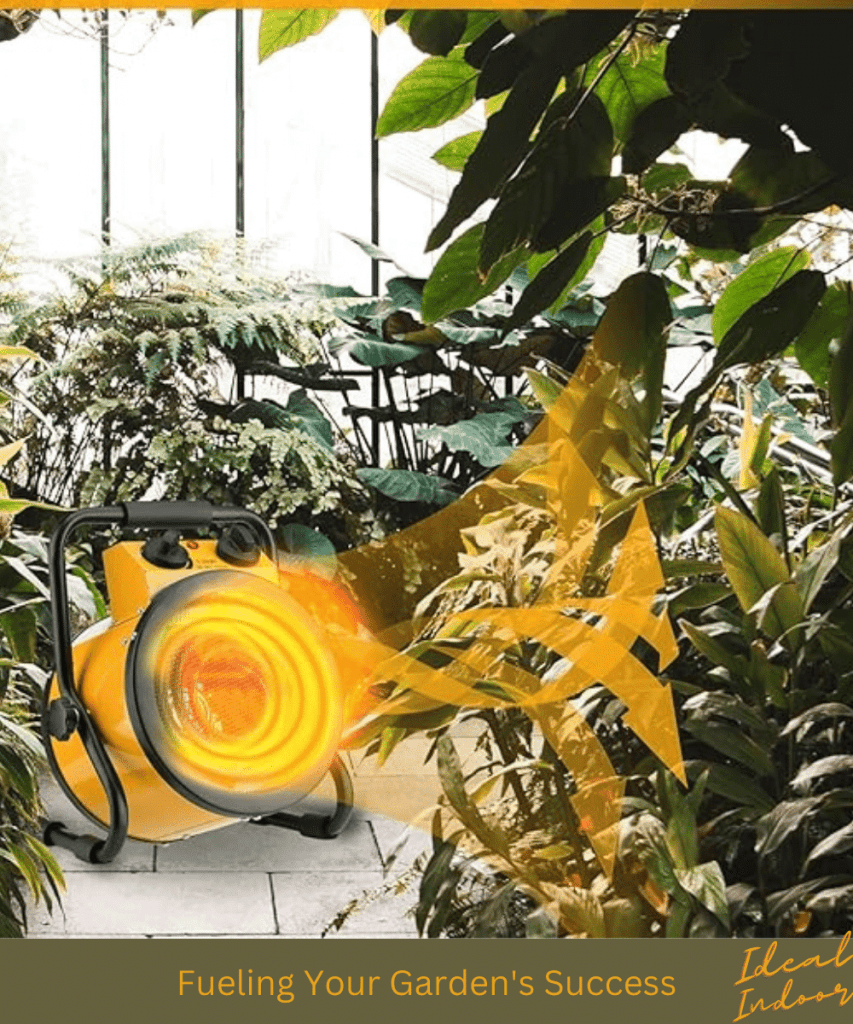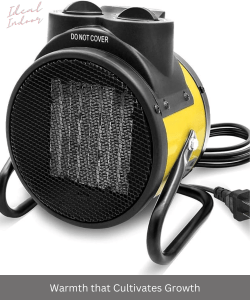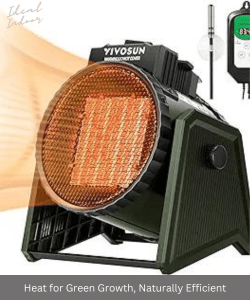Imagine stepping into your greenhouse in the dead of winter to find a vibrant, thriving oasis, defying the frosty air outside. This is not merely a fantasy for enthusiastic gardeners; it is an actuality that may be achieved with the appropriate greenhouse heater.
Who loves a garden loves a greenhouse too.
When attempting to garden throughout the year, individuals who are passionate about greenhouses frequently encounter the difficulty of preserving an appropriate atmosphere to support the growth of plants. An essential aspect of this undertaking involves choosing a suitable greenhouse heater.
Having an appropriate greenhouse heater is essential for effectively caring for delicate plants and ensuring optimal growing conditions. Within this review, we will explore the different categories of greenhouse heaters, elements to take into account when selecting one, and intelligent methods to improve the heating of your greenhouse.
By the end, you’ll have all the knowledge needed to make the best decision for your greenhouse heating needs.
Understanding Greenhouse Heaters
Greenhouse heaters play a crucial role in regulating the temperature inside a greenhouse, particularly in colder seasons. The heaters are available in different varieties, including electric, solar-powered, gas-powered, and paraffin-based. Each variety has its distinct advantages. It is essential to know how efficient these heaters are, how much heat they can produce, how to manage the temperature, and whether or not they have any safety measures before buying one. Regardless of the size of the greenhouse, selecting the appropriate heater is crucial for achieving efficient heating and maintaining the health of your plants. This will create an optimal atmosphere for their growth and nurturing.
The Importance of a Greenhouse Heater
A greenhouse heater is vital for maintaining the ideal temperature and creating a conducive environment for plants to thrive. It ensures that delicate and tender plants are protected from harsh weather conditions, especially during the colder months. Through the provision of effective heating, it aids in the progression of the growing season, enabling the robust growth of tropical plants and establishing an optimal temperature range for a variety of species. In addition, the installation of a greenhouse heater assists in maintaining a consistent temperature within the environment, allowing for continuous cultivation throughout the year and promoting the overall health of plants.
How a Greenhouse Heater Works
A greenhouse heater functions by employing different heat sources to elevate the temperature within the greenhouse to the required level. Whether it’s an electric, solar-powered, gas, or paraffin-based heater, the primary goal is to provide efficient heating for the tender plants. These heaters function by generating and distributing warm air or radiant heat while ensuring enough air circulation. Typically, these devices are furnished with adaptable thermostats and safety functionalities like oxygen depletion sensors, providing reassurance to those who own greenhouses.
Types of Greenhouse Heaters for 2024
Electric Greenhouse Heaters
These are popular for their energy efficiency and ease of use. Solar Powered Greenhouse Heaters: Optimal for eco-friendly heating, making use of renewable energy sources. Gas-Powered Greenhouse Heaters: Renowned for their high heat output, making them appropriate for bigger greenhouses. Paraffin-based greenhouse heaters are well-suited for compact areas, as they offer a steady heat source and require less upkeep. Every model provides distinct advantages that cater to a variety of greenhouse requirements, guaranteeing optimal temperature and comfort for delicate plants.
Solar Powered Greenhouse Heaters
Solar-powered greenhouse heaters offer an environmentally responsible alternative for regulating the optimum temperature within your greenhouse. Through the utilization of solar energy, these heaters provide effective heating while reducing their ecological footprint. The utilization of solar panels enables the conversion of sunshine into electricity, resulting in long-term cost-effectiveness. Solar-powered greenhouse heaters offer the advantage of being able to function autonomously from the electrical grid, making them well-suited for rural or off-grid areas. In addition, they make a substantial contribution to energy conservation and are a highly suitable option for greenhouse owners who prioritize environmental sustainability.
Gas-Powered Greenhouse Heaters
Gas-powered greenhouse heaters with robust heating capabilities offer a compelling option for bigger greenhouses. These heaters typically use propane as their fuel source, offering efficient heating for large areas. Due to their elevated BTU rating, these heaters can rapidly increase the temperature within the greenhouse, which makes them well-suited for colder climates. In addition, gas-powered heaters frequently have safety measures like an oxygen depletion sensor, which guarantees a secure setting for your plants. When choosing a gas-powered greenhouse heater, it is important to take into account the dimensions of your greenhouse and the expenses associated with heating in order to arrive at a well-informed choice.
Paraffin-Based Greenhouse Heaters
Paraffin-based greenhouse heaters are a cost-effective option for owners of small greenhouses. These heaters offer consistent warmth, which makes them appropriate for delicate plants. These heaters exhibit user-friendly operation and necessitate minimal upkeep. Nevertheless, their heating capability may need to be improved for larger greenhouses. In addition, it is essential to have sufficient ventilation while using paraffin heaters in order to avoid the accumulation of fumes. Although cost-effective, users need to emphasize safety and explore alternate methods for bigger or commercial greenhouse operations.
Selecting the Right Greenhouse Heater
When choosing a suitable greenhouse heater, it is important to take into account many factors, such as heating capacity, temperature control, safety features, and energy economy. Evaluate the dimensions of your greenhouse and determine the necessary heating capacity to sustain the specified temperature range. An ideal heater would possess an adjustable thermostat control, sufficient ventilation, and precise temperature control. The presence of safety elements, such as oxygen depletion sensors and carbon monoxide detectors, is of utmost importance. In addition, it is advisable to give priority to heaters that are energy-efficient in order to decrease heating expenses and minimize the environmental consequences.
Heating Capacity
When choosing a greenhouse heater, it is important to take into account the heating capacity. The heating capacity must be proportional to the size of your greenhouse in order to achieve optimal heating efficiency. Calculate the total area of your space and then compare it to the covering area of the heater. In addition, it is important to consider the intended temperature range and the external climate when choosing a heater with suitable British Thermal Units (BTUs). This will guarantee that your delicate plants are maintained at the appropriate temperature to promote their best possible growth.
Temperature Control
Temperature management plays a significant role when selecting a greenhouse heater. Seek out heaters equipped with adjustable thermostats in order to effectively regulate the temperature required for your plants. Please take into account the dimensions of your greenhouse and the heating capacity of the heater to ensure it is capable of sufficiently warming the area. Digital thermostats give accurate control, whereas heaters with different heat settings offer versatility. In addition, it is crucial to include safety measures like oxygen depletion sensors and proper ventilation in order to maintain the optimal temperature for plant health. It is important to give priority to temperature regulation in order to achieve effective and optimal greenhouse heating.
Size and Insulation of the Greenhouse
The dimensions and insulation of the greenhouse significantly impact the efficiency of a greenhouse heater. It is important to evaluate the size of the area and the quality of insulation when considering a heating solution since larger spaces or inadequate insulation may necessitate a more robust option.
Types of Plants and Temperature Needs
Various plant species flourish under varying temperature conditions. Comprehending the precise temperature needs of your plants is crucial when choosing a heater that can sustain the optimal conditions for their growth and well-being.
Safety Features
When selecting a greenhouse heater, it is crucial to prioritize safety aspects. Seek out heaters equipped with oxygen depletion sensors in order to mitigate the risk of carbon monoxide accumulation. In addition, it is advisable to choose models that are fitted with tip-over switches in order to prevent unintentional fires. To enhance your sense of security, it is advisable to contemplate heaters that include cool-touch exteriors, particularly if you have young ones or animals. Finally, it is advisable to verify the presence of certificates such as UL or CSA in order to confirm that the heater complies with safety regulations. Emphasizing safety elements will contribute to the overall security of your greenhouse and the individuals inside.
Energy Efficiency
Energy efficiency is an important aspect to take into account when choosing a greenhouse heater. Look for heaters with adjustable thermostat control, precise temperature control, and appropriate ventilation to ensure optimum energy usage. Propane heaters, solar-powered heaters, and electric heaters equipped with digital displays offer effective solutions for controlling temperature levels while reducing energy expenses. In addition, the selection of a heater with a BTU rating that matches the dimensions of your greenhouse can have a positive impact on energy conservation. Placing a high priority on energy efficiency has the dual advantage of lowering operational expenses and positively impacting the environment.
Best 3 Greenhouse Heaters for 2024
In 2024, the best greenhouse heaters combine efficiency and advanced features to meet the diverse needs of greenhouse owners. From powerful electric heaters with adjustable thermostats to solar-powered options for sustainable heating, the market offers a wide range of innovative solutions. Gas-powered heaters, including propane and natural gas options, are designed for reliable and fast heating, while paraffin-based heaters provide an effective fuel source. With a focus on energy savings, safety features, and precise temperature control, these top greenhouse heaters ensure optimal growing conditions.
Nurturing Warmth: The LHUKSGF Greenhouse Heater – A Gardener’s Reliable Companion
The LHUKSGF Greenhouse Heater, equipped with a digital thermostat, is a versatile and efficient heating solution for spaces up to 150 ft². It offers a substantial 5118 BTU/1500 W output, ideal for greenhouses, workshops, and home environments. Its user-friendly features include a temperature range of 40℉-108℉, adjustable in both Fahrenheit and Celsius and an automatic shut-off for safety and energy savings. Portability is enhanced by its non-slip handle and base, making it easy to move. The heater’s durability is assured with a stainless steel build and IPX4 waterproof rating, ensuring a longer life cycle. Overall, this heater is a practical choice for those needing a reliable, safe, and effective heating solution.
Stay Warm All Year Round with Buyplus Outdoor Heater
The Buyplus Greenhouse Heater with Digital Thermostat is a powerful 1500W heater designed for greenhouses, patios, garages, and more. It rapidly warms up to 215 sq ft, offers precise temperature control, and includes safety features like overheat protection. With two working modes and a user-friendly design, it’s perfect for year-round use. Plus, it comes with a 1-year warranty.
Warmth and Growth: The VIVOSUN 1500W Portable Greenhouse Heater – A Game-Changer for Gardeners
The VIVOSUN 1500W Portable Greenhouse Heater is a versatile and efficient heating solution, perfect for various settings like greenhouses, grow tents, and home spaces. Featuring both fan and heater modes (750W & 1500W), it offers flexibility for all-season use. Safety is prioritized with automatic shut-off at 108°F and flame-retardant materials. Its digital thermostat, adjustable from 40°F to 108°F, ensures precise temperature control. The heater’s design.
Smart Ways to Enhance Your Greenhouse Heating
Improving Insulation
When it comes to improving insulation in your greenhouse, consider using double-layered polyethene or bubble wrap to cover windows and doors. This can prevent heat loss while still allowing sunlight to enter. Additionally, installing weather stripping around doors and vents can help seal any gaps and reduce heat escape. Another option is to use thermal curtains or blankets during the night to trap the warmth inside. Proper insulation ensures that your greenhouse retains heat efficiently, creating an ideal environment for your plants to thrive.
Using Thermal Mass
Using thermal mass in your greenhouse can be an effective way to regulate temperature. By incorporating materials like water barrels or stone walls, you can store heat during the day and release it at night, helping to maintain a consistent climate for your plants. This method is especially beneficial in cold climates or during the growing season when temperatures fluctuate. Additionally, thermal mass can help reduce heating costs and create a more energy-efficient environment, making it a smart choice for greenhouse heating. Utilizing thermal mass provides a natural and sustainable solution for temperature control.
Integrating a Thermostat
Integrating a thermostat into your greenhouse heating system is crucial for maintaining the desired temperature. By using an adjustable thermostat, you can ensure that your tender plants are kept at the ideal temperature for optimal growth. A digital thermostat provides precise temperature control, allowing you to create the perfect environment for your plants. This integration also contributes to energy efficiency, as the thermostat helps regulate heating based on the specific needs of your greenhouse, ultimately leading to cost savings and peace of mind.
Maintenance Tips for Greenhouse Heaters
Regular maintenance is crucial for the optimal performance of greenhouse heaters. Start by scheduling regular cleaning to remove dust and debris, ensuring efficient heating. Conduct timely repairs to address any issues and prevent costly malfunctions. Perform seasonal checks to verify that all components are functioning as intended, promoting a healthy environment for your plants. By prioritizing maintenance, you can prolong the lifespan of your greenhouse heaters and maintain a consistent and comfortable climate for your plants, ultimately maximizing their growth and yield.
Regular Cleaning
Regular cleaning of your greenhouse heater is essential for optimal performance. Dust and debris can accumulate, affecting air circulation and heating efficiency. Start by turning off the heater and allowing it to cool. Then, gently vacuum the exterior to remove surface dust. Use a soft brush to clean the air vents and grills. Check the power cord for any damage, and wipe the heater with a damp cloth. Remember to follow the manufacturer’s instructions for specific cleaning guidelines. Regular maintenance ensures a longer lifespan for your greenhouse heater.
Timely Repairs
Ensuring timely repairs for your greenhouse heater is crucial for maintaining a conducive environment. Regularly inspect all components, especially the thermostat, heating elements, and ventilation system. Additionally, check for any signs of wear and tear or corrosion. Promptly replace any damaged parts to prevent further issues. Ignoring small problems can lead to more extensive damage and costly repairs in the future. By addressing problems early, you can maintain efficient heating and create an optimal growing environment for your plants.
Seasonal Checks
When maintaining greenhouse heaters, seasonal checks are crucial. Before the growing season:
- Inspect the entire heating system, including vents and ducts, to ensure they are free from debris.
- Check the thermostat for accuracy and calibrate if necessary.
- Verify the fuel source for gas or propane heaters and ensure it’s sufficient for the upcoming season.
- Test all safety features, such as oxygen depletion sensors and carbon monoxide detectors, to guarantee they are functioning correctly.
To ensure optimal growth and protect your plants during the colder months, investing in a high-quality greenhouse heater is essential. With various types of heaters available for 2024, selecting the right one can be overwhelming. Factors such as heating capacity, temperature control, safety features, and energy efficiency must be considered.
In this comprehensive review, we’ve unveiled the best greenhouse heaters for 2024. Heater 1, Heater 2, Heater 3, Heater 4, and Heater 5 are all top contenders that offer excellent performance and reliability.
To enhance your greenhouse heating, consider improving insulation, using thermal mass, and integrating a thermostat. These smart techniques will help maintain a consistent and comfortable environment for your plants.
Remember maintenance! Regular cleaning, timely repairs, and seasonal checks will prolong the lifespan of your greenhouse heater and ensure its efficient operation.
Now, you can confidently choose the best greenhouse heater and create the ideal growing conditions for your plants. Happy gardening!
Frequently Asked Questions
What is the ideal temperature for a greenhouse in winter?
The ideal temperature for a greenhouse in winter typically ranges from 45°F to 50°F during the night and 65°F to 70°F during the day. This range provides optimum conditions for plant growth while preventing frost damage.
How do you choose the most energy-efficient greenhouse heater?
Selecting the most energy-efficient greenhouse heater involves considering factors like insulation, thermostat integration, and energy source. Look for heaters with good insulation, adjustable thermostats, and energy-efficient power sources like solar or electric. Consider these factors to make an eco-friendly and cost-effective choice.




